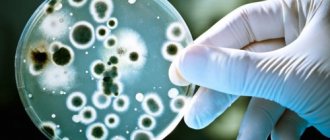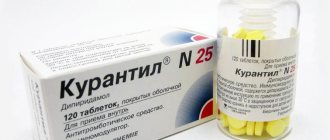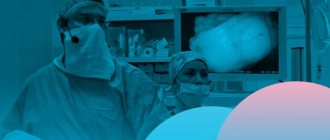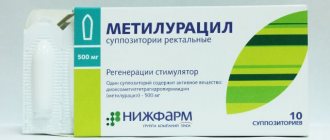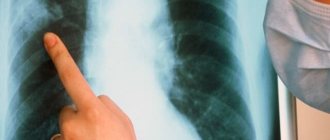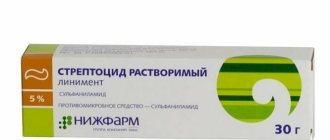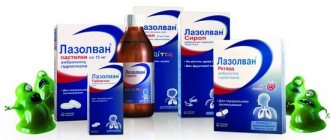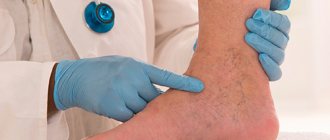What are bacteriophages
Without exception, all viruses are parasites that live at the expense of others. Bacteriophages are no exception. They only exist where bacteria can be found. And since harmful microorganisms are everywhere - in the air, in water, in soil, in humans, it means that there are bacteriophages everywhere. The species of these tiny predators (a bacteriophage is 100 times smaller than the average bacterium) differ, but the principle of their “hunting” is almost the same. Outwardly, they resemble a fantastic space module, which has a “central compartment” - a head in which the DNA or RNA of a bacteriophage is stored, a “connecting gateway” - a tail in the form of a hollow tube through which DNA moves to the bacterium, and “supporting posts” - threads that the bacteriophage attaches itself to its prey. The shape of their heads can be very different, and the tail of some of them has a cover in which the rod is hidden until it is needed.
special instructions
Before use, the bottle with the drug must be shaken and its transparency and the presence of sediment assessed. If turbidity or sediment is detected, the drug should not be used!
Due to the presence in the drug of a favorable climate for the development of microorganisms from the environment that cause turbidity of the solution, opening the bottle should be done according to the rules indicated below:
- hands must be washed thoroughly before working with the product;
- before removing, the lid must be treated with an alcohol-containing solution;
- remove the cap without removing the stopper;
- the drug should be removed from an opened container only by piercing the stopper with a sterile syringe;
- if during opening the cork was accidentally removed along with the cap, then it must not be placed on the table with the inner surface, and the container should not be left open (after taking the solution, it must be sealed with a cork);
- The opened bottle should be stored in the refrigerator.
If these rules are followed and there is no turbidity, then the coli bacteriophage from an open bottle can be used for 2 years (the entire shelf life).
How bacteriophages deal with bacteria
Having found the desired bacterium, the small predator attaches itself to its surface. Enzymes located in the tail of the bacteriophage dissolve the bacterial membrane, making a hole in it through which the “host” injects its DNA. Once in the bacterium, it completely changes its metabolism and begins to create its own proteins, RNA, DNA, that is, to form the “babies” of the pathogen eater. When this process ends, the bacterium ruptures, and young bacteriophages spill out into the environment.
Species of some families of these creatures “eat” the bacterium in a couple of minutes, which is difficult to overestimate in medical practice. Doctors have recently resorted to using bacteriophages more and more often, because drugs from these viruses have no side effects, are combined with almost all medications, including antibiotics, and do not suppress the immune system. Even infants are treated with bacteriophages, they are so harmless.
Pathologies caused by fecal enterococci
Most often, fecal enterococci provoke the development of pathologies in the urogenital system, such as:
- Pyelonephritis.
- Cystitis.
- Urethritis.
In addition, infection of the genital organs with microorganisms is possible, which may result in the following:
- Inflammation of the prostate.
- Adnexitis.
- Vulvitis.
- Vaginitis.
Enterococci can also cause food poisoning, enteritis, dysbacteriosis, and gastritis.
In rare cases, damage to the brain and heart and the development, respectively, of meningitis and endocarditis are observed. In the absence of adequate therapy in conditions of reduced immunity, there is a risk of developing sepsis.
Weaknesses of such therapy
Bacteriophages, the types of which “work” only with “their” bacteria, are called: dysentery, staphylococcal, streptococcal, and so on. This feature is considered a disadvantage of beneficial viruses.
There is also a version, which, however, is only being tested, that bacteriophages destroy bacteria as long as there are many of them. As soon as the number of these microorganisms decreases, and there is no place for bacteriophages to multiply, they stop destroying pathogens, thereby regulating their number. Therefore, when treating with some drugs of this type, it is necessary to undergo repeated courses. However, they are indispensable in the treatment of purulent wounds, otitis media, runny nose, urological diseases, gastroenterocolitis and others. Thus, the biological product “Klebsiella polyvalent purified bacteriophage” has a high therapeutic effect. It kills dangerous Klebsiella bacteria that cause pneumonia, sepsis in infants and newborns, ENT diseases, gastrointestinal tract, omphalitis and other diseases. The drug is available in ampoules and vials. It is used externally, locally, internally, and is used for inhalation and rinsing.
Symptoms
At the beginning of infection, no deterioration in a person’s well-being occurs. But tests at this stage can already show the presence of bacteria. Over time, as the infection progresses, the following symptoms develop:
- In men, potency decreases. Women experience pain during sexual intercourse.
- General malaise, fever.
- Inflammation of the urethra.
- Pain in the bladder.
- Redness, inflammation of the genitals.
- Pain when urinating, frequent urge.
Diagnosis involves primarily laboratory testing of urine samples for enterococcus faecium. A general examination of urine is carried out.
In women, fecal enterococci can also be detected in a gynecological smear.
One cure for six diseases
The product “Bacteriophage sextaphage” can cope with staphylococci, Proteus, streptococci, pneumonia caused by Klebsiella, Escherichia coli and Pseudomonas aeruginosa, because it contains six types of beneficial viruses at once.
The spectrum of action of the drug is extremely wide. It is used in the treatment of various types of infections, including surgical and urogenital, septic, purulent-inflammatory diseases, tonsillitis, tonsillitis, pneumonia and many other pathologies. The medicine has no contraindications, no side effects were observed. The drug is available in capsules and vials.
Instructions for use
The liquid product can be used for oral, local, rectal use. The solution is also suitable for draining cavities, irrigation and applications. In some cases, the medicine should be used both internally and for local treatment of purulent-inflammatory areas. Unlike antibiotics, bacteriophage therapy lasts from 7 to 20 days.
Oral use of the solution is indicated for cystitis, pyelonephritis and urethritis. When draining the bladder or renal pelvis, the medicine is administered through a drainage tube. It is recommended to take 20-30 ml of solution orally for patients over 8 years of age. No more than 30 ml can be injected into the bladder cavity, and 6-7 ml of solution per day into the pelvis.
Diseases of the ENT organs can be treated with coli bacteriophage by washing, instilling and rinsing. The medicine is particularly effective when turundas soaked in a solution are introduced into the nasal or ear cavity.
Bacteriophage coli for dysbacteriosis and other pathologies of the digestive tract should be taken orally, 20-30 ml three times a day, at least an hour before meals. The duration of such therapy is 3 weeks.
Gynecological ailments of an infectious nature are treated by injecting a solution into the vagina or uterus. One dose will require 5-10 ml of solution. For colpitis, packing should be done twice a day.
After emptying the abscess cavity, the drug is administered in a smaller quantity than the volume of removed pus. The bacteriophage is also poured into the wound in a dose of 10-20 ml for osteomyelitis after appropriate treatment of the wound.
Are there any contraindications and side effects?
Of course, many people are interested in the question of whether all categories of patients are allowed to take the drug “Piobacteriophage”? The instructions state that this product has no contraindications. Moreover, no cases of severe adverse reactions have been reported. Sometimes patients experience a slight allergic reaction, but this is extremely rare.
The drug “Pyobacteriophage complex liquid” is often used to treat even newborns. Moreover, the drug is indispensable in the treatment of certain infections during pregnancy, because during this period of a woman’s life, traditional antibacterial therapy with antibiotics can only do harm.
But, despite all the safety, you should not use the medicine without permission - be sure to consult your doctor before starting therapy.
How much does the medicine cost?
For many patients, the issue of cost of a particular medicine is important. So how much will the drug “Piobacteriophage” cost? The price, of course, may fluctuate depending on the volume you purchase, the manufacturer, as well as the financial policy of the pharmacy.
On average, a package costs 900 rubles. But you need to keep in mind that to complete the full course of treatment you will most likely need several of these packages.
What to do if, for one reason or another, you cannot use the “Complex Liquid Pyobacteriophage”? The bacteriophage is also contained in some other drugs; if necessary, you can choose a substitute with almost the same properties. For example, such products as “Piobacteriophage polyvalent purified”, “Piopolyphage”, “Sextaphage” and some others are considered good analogues.
Prescription for children
The drug is widely used in pediatrics. What do they say about such a medicine as staphylococcal bacteriophage? For infants, a disease such as omphalitis is very dangerous. It is manifested by suppuration at the umbilical wound, redness of the skin around it and swelling, as well as an inflammatory process in the subcutaneous fat layer. The cause of this disease is a staphylococcal infection. Progression of the disease can lead to sepsis. Timely, systematic treatment of the wound with a composition such as staphylococcal bacteriophage will help quickly neutralize the effect of harmful microorganisms, which will lead to recovery.
Another common disease in infants is vesiculopustulosis. It is characterized by skin lesions, which are accompanied by the formation of bubbles with cloudy contents. The condition of the little patient depends on the number of rashes. The cause of the disease is also a staphylococcal infection, which can be defeated through lotions with a remedy such as staphylococcal bacteriophage.
Treatment
Therapy for enterococcus faecium requires a multifaceted approach. As a rule, it involves the use of antimicrobial medications, restoration of intestinal microflora, and strengthening of the immune system.
- Probiotics. Infection with enterococci indicates a violation of the intestinal microflora, and in addition it is harmed by the use of antibiotics. Prescribing Acipol and Bifidumbacterin to the patient will allow the microflora to return to normal.
- Immunostimulants. An integral part of the treatment of infection is the use of immunostimulating agents, for example, drugs based on echinacea (for example, Immunala). In addition, it is recommended to take vitamin and mineral complexes.
- Bacteriophages. Bacteriophages are viruses that can parasitize various bacteria. Moreover, they are absolutely safe for humans. These drugs can be prescribed to pregnant women and infants. Often their use is combined with antibacterial therapy.
- Antibiotics. These drugs are not always suitable for therapy. In addition, enterococci are resistant to antibacterial agents, so the prescription should be prescribed exclusively by a specialist after conducting some research. The most commonly used antibiotics are from the group of gentamicins, ampicillins, and ceftriaxone.
We looked at what it means to detect enterococcus fecium in a smear. Treatment for enterococcus faecium is best left to a specialist.
Release form and composition
Available in the form of a solution for oral, external and local use, which is a clear yellow liquid from a slightly yellowish tint to a more saturated yellow color. Packaging – bottles of 20 ml or 100 ml; 1 bottle of 100 ml is placed in a cardboard box along with instructions for use of Staphylococcal Bacteriophage; 4 or 8 bottles of 20 ml.
Composition per 1 ml of solution:
- active ingredient: sterile filtrate of phagolysates of Staphylococcus bacteria (up to 1 ml);
- auxiliary components: preservative 8-hydroxyquinoline sulfate monohydrate or 8-hydroxyquinoline sulfate.
Prevention
Preventive actions:
- Hygiene. Hygiene is not a direct cause of the development of such infections, however, with insufficient hygiene, the risk of infection increases with weakened immunity. It is important to wash your hands, not eat dirty fruits and vegetables, maintain intimate hygiene, and treat scratches and cuts with iodine.
- Diet. Prevention of infection is facilitated by eating foods rich in vitamins and microelements: fruits, berries, herbs, vegetables, honey, nuts. This diet will support your immune system. It is also necessary to consume fermented milk products daily, which help maintain intestinal microflora in a normal state.
